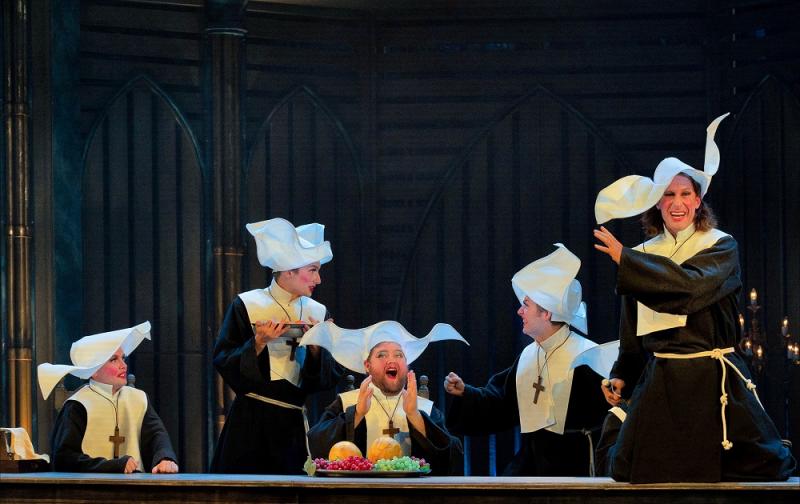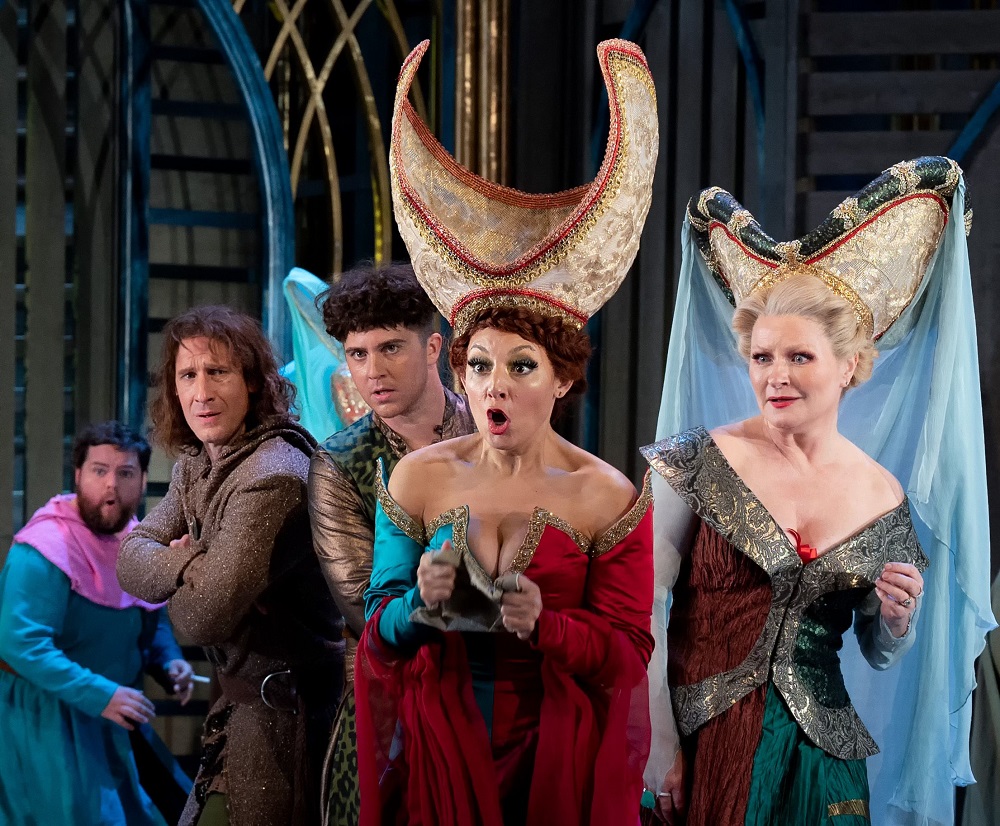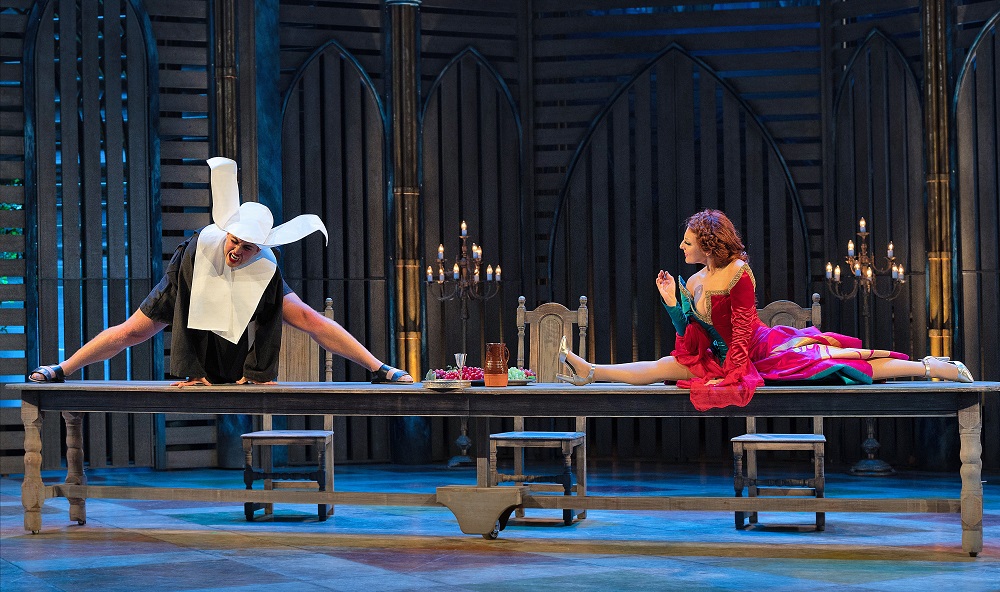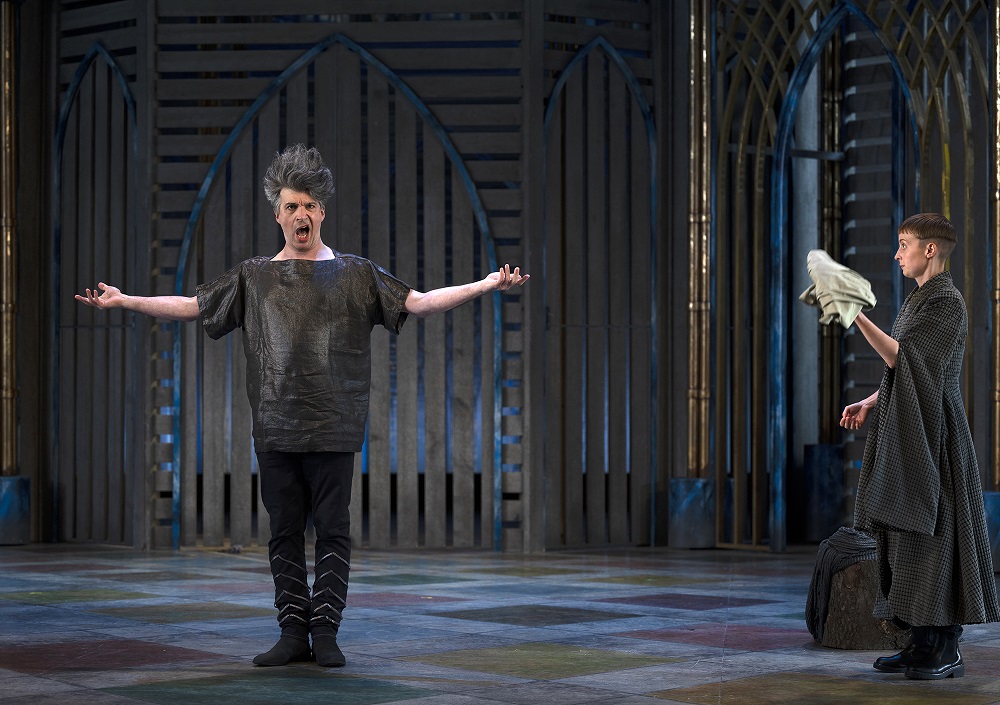Le Comte Ory, Garsington Opera review - high musical style and broad dramatic comedy | reviews, news & interviews
Le Comte Ory, Garsington Opera review - high musical style and broad dramatic comedy
Le Comte Ory, Garsington Opera review - high musical style and broad dramatic comedy
Rossini can take the high jinks of Cal McCrystal in a deliciously cast romp

Play it straight and you’ll get more laughs: that’s the standard advice on great operatic comedies like the masterpieces of the Gilbert & Sullivan canon, Britten’s Albert Herring, Verdi’s Falstaff, Puccini’s Gianni Schicchi.
Last night’s performance, the penultimate, was the first of two with Robert Murray, vintage tenor with a gift for comedy, replacing Jack Swanson as the licentious Count Ory who’s determined to seduce the Countess Adèle (all the women have taken up chastity while the real men are away at the Crusades). Murray may not be the born Rossini tenore di grazie of the kind indicated by Swanson’s biography, but he carries the vocal pyrotechnics with dramatic panache. He also looks as if he’s always been part of the ensemble – he’s used to Garsington operetta – as he juggles oranges, does the quickest of changes into Groucho Marx glasses and eyebrows and throws himself, though presumably with choreographic care, into the Act Two antics where he and his men disguise themselves as nuns to wheedle their way into the castle where Adèle and female company are sequestered.  That one-act plot, such as it is, was Rossini’s original idea; to add a kind of “prequel” setting up the characters and requiring Ory to adopt another pose as an hermetic expert on amatory matter, might have been a mistake. Musically there’s plenty of lively writing for the chorus; one of the two 24-strong groups at Garsington is superb from the start, and McCrystal gives them Spamalot-meets-1200-headdress costumes (by Takis, in garish accord with his open set) as well as stylised mugging roles as individuals (though the gag of the Snow White witch with apple shouldn't have lasted beyond the first scene).
That one-act plot, such as it is, was Rossini’s original idea; to add a kind of “prequel” setting up the characters and requiring Ory to adopt another pose as an hermetic expert on amatory matter, might have been a mistake. Musically there’s plenty of lively writing for the chorus; one of the two 24-strong groups at Garsington is superb from the start, and McCrystal gives them Spamalot-meets-1200-headdress costumes (by Takis, in garish accord with his open set) as well as stylised mugging roles as individuals (though the gag of the Snow White witch with apple shouldn't have lasted beyond the first scene).
It does, though, take an awfully long time before we meet heroine Adèle. And then things really spark with petite American soprano Andrea Carroll going against the grain of the languishing virgin (as Rossini’s music does too) by putting her yoga training to good use in some extraordinary collapses (in Act Two this Adele irritates Ory and her companion Ragonde – true contralto Patricia Bardon (pictured above on the right with Carroll's Adèle centre, Jacques Imbrailo and the first Ory, Jack Swanson), another stylish singer totally at ease on stage – with her agility, which they imitate in vain, and ends up doing the splits on the dining table, pictured below). Vocally she’s a dream lyric coloratura, singing so many roles at the Vienna State Opera; Garsington could build an Ariadne auf Naxos around Carroll's putatively acrobatic Zerbinetta.  No-one else comes off second best to these two. Jacques Imbrailo and Joshua Bloom kick off with spoken comedy business at the start – this Raimbaud thinks he’s supposed to be Rambo, and Bloom acts out anger at not getting the principal role because of the three-in-a-bed scene – and provide stentorian backbone in solos and ensembles (the one which kicks off the Act One finale, adapted from the “Gran Pezzo Concertato” in Rossini’s previous opera, Il viaggio a Reims, gets a round of applause when it blazes into ensemble a cappella at the revelation of Ory’s disguise – a bit like “Hail, Poetry” in The Pirates of Penzance. We’re simply thrilled to be hearing full-throttle choruses again, anyway). Katie Bray (pictured below with Bloom) is vibrant and delicious in the principal-boy role of Isolier the page – yes, this is pantoland – and blends beautifully in duet with Carroll.
No-one else comes off second best to these two. Jacques Imbrailo and Joshua Bloom kick off with spoken comedy business at the start – this Raimbaud thinks he’s supposed to be Rambo, and Bloom acts out anger at not getting the principal role because of the three-in-a-bed scene – and provide stentorian backbone in solos and ensembles (the one which kicks off the Act One finale, adapted from the “Gran Pezzo Concertato” in Rossini’s previous opera, Il viaggio a Reims, gets a round of applause when it blazes into ensemble a cappella at the revelation of Ory’s disguise – a bit like “Hail, Poetry” in The Pirates of Penzance. We’re simply thrilled to be hearing full-throttle choruses again, anyway). Katie Bray (pictured below with Bloom) is vibrant and delicious in the principal-boy role of Isolier the page – yes, this is pantoland – and blends beautifully in duet with Carroll.  Rossini saves the highlight, though, for near the end: a trio of confusion, delectably orchestrated, when the Count abandons his wimple and creeps into Adèle’s bedroom where Isolier is already installed. Up to this point, McCrystal’s humour is fun, but not quite of the laugh-until-you-cry variety he unleashed in the ENO Iolanthe. This above all is the scene which fits most perfectly his definition of the “rubber chicken served up on a gold plate”.. Adele constructs a dummy out of pillows and linen, Ory falls both for and on it (Murray hilarious at this point), and then the lady and the page use hands on sticks to fondle the fooled Count all over.
Rossini saves the highlight, though, for near the end: a trio of confusion, delectably orchestrated, when the Count abandons his wimple and creeps into Adèle’s bedroom where Isolier is already installed. Up to this point, McCrystal’s humour is fun, but not quite of the laugh-until-you-cry variety he unleashed in the ENO Iolanthe. This above all is the scene which fits most perfectly his definition of the “rubber chicken served up on a gold plate”.. Adele constructs a dummy out of pillows and linen, Ory falls both for and on it (Murray hilarious at this point), and then the lady and the page use hands on sticks to fondle the fooled Count all over.
The music is almost lost here in gales of laughter, but Valentina Peleggi goes on winning jewelled colours and phrases from the wonderful Philharmonia in the pit. She’s another revelation in what is an evening of unadulterated pleasure, if you let yourself go. Fortunately it’s being or has been filmed, so a wider audience should get to share in the fun. There’s nothing quite like sharing in the mirth live, though, and how we need a good laugh right now.
The future of Arts Journalism
You can stop theartsdesk.com closing!
We urgently need financing to survive. Our fundraising drive has thus far raised £49,000 but we need to reach £100,000 or we will be forced to close. Please contribute here: https://gofund.me/c3f6033d
And if you can forward this information to anyone who might assist, we’d be grateful.

Subscribe to theartsdesk.com
Thank you for continuing to read our work on theartsdesk.com. For unlimited access to every article in its entirety, including our archive of more than 15,000 pieces, we're asking for £5 per month or £40 per year. We feel it's a very good deal, and hope you do too.
To take a subscription now simply click here.
And if you're looking for that extra gift for a friend or family member, why not treat them to a theartsdesk.com gift subscription?
more Opera
 Albert Herring, English National Opera review - a great comedy with depths fully realised
Britten’s delight was never made for the Coliseum, but it works on its first outing there
Albert Herring, English National Opera review - a great comedy with depths fully realised
Britten’s delight was never made for the Coliseum, but it works on its first outing there
 Carmen, English National Opera review - not quite dangerous
Hopes for Niamh O’Sullivan only partly fulfilled, though much good singing throughout
Carmen, English National Opera review - not quite dangerous
Hopes for Niamh O’Sullivan only partly fulfilled, though much good singing throughout
 Giustino, Linbury Theatre review - a stylish account of a slight opera
Gods, mortals and monsters do battle in Handel's charming drama
Giustino, Linbury Theatre review - a stylish account of a slight opera
Gods, mortals and monsters do battle in Handel's charming drama
 Susanna, Opera North review - hybrid staging of a Handel oratorio
Dance and signing complement outstanding singing in a story of virtue rewarded
Susanna, Opera North review - hybrid staging of a Handel oratorio
Dance and signing complement outstanding singing in a story of virtue rewarded
 Ariodante, Opéra Garnier, Paris review - a blast of Baroque beauty
A near-perfect night at the opera
Ariodante, Opéra Garnier, Paris review - a blast of Baroque beauty
A near-perfect night at the opera
 Cinderella/La Cenerentola, English National Opera review - the truth behind the tinsel
Appealing performances cut through hyperactive stagecraft
Cinderella/La Cenerentola, English National Opera review - the truth behind the tinsel
Appealing performances cut through hyperactive stagecraft
 Tosca, Royal Opera review - Ailyn Pérez steps in as the most vivid of divas
Jakub Hrůša’s multicoloured Puccini last night found a soprano to match
Tosca, Royal Opera review - Ailyn Pérez steps in as the most vivid of divas
Jakub Hrůša’s multicoloured Puccini last night found a soprano to match
 Tosca, Welsh National Opera review - a great company reduced to brilliance
The old warhorse made special by the basics
Tosca, Welsh National Opera review - a great company reduced to brilliance
The old warhorse made special by the basics
 BBC Proms: The Marriage of Figaro, Glyndebourne Festival review - merriment and menace
Strong Proms transfer for a robust and affecting show
BBC Proms: The Marriage of Figaro, Glyndebourne Festival review - merriment and menace
Strong Proms transfer for a robust and affecting show
 BBC Proms: Suor Angelica, LSO, Pappano review - earthly passion, heavenly grief
A Sister to remember blesses Puccini's convent tragedy
BBC Proms: Suor Angelica, LSO, Pappano review - earthly passion, heavenly grief
A Sister to remember blesses Puccini's convent tragedy
 Orpheus and Eurydice, Opera Queensland/SCO, Edinburgh International Festival 2025 review - dazzling, but distracting
Eye-popping acrobatics don’t always assist in Gluck’s quest for operatic truth
Orpheus and Eurydice, Opera Queensland/SCO, Edinburgh International Festival 2025 review - dazzling, but distracting
Eye-popping acrobatics don’t always assist in Gluck’s quest for operatic truth
 MARS, Irish National Opera review - silly space oddity with fun stretches
Cast, orchestra and production give Jennifer Walshe’s bold collage their all
MARS, Irish National Opera review - silly space oddity with fun stretches
Cast, orchestra and production give Jennifer Walshe’s bold collage their all

Add comment